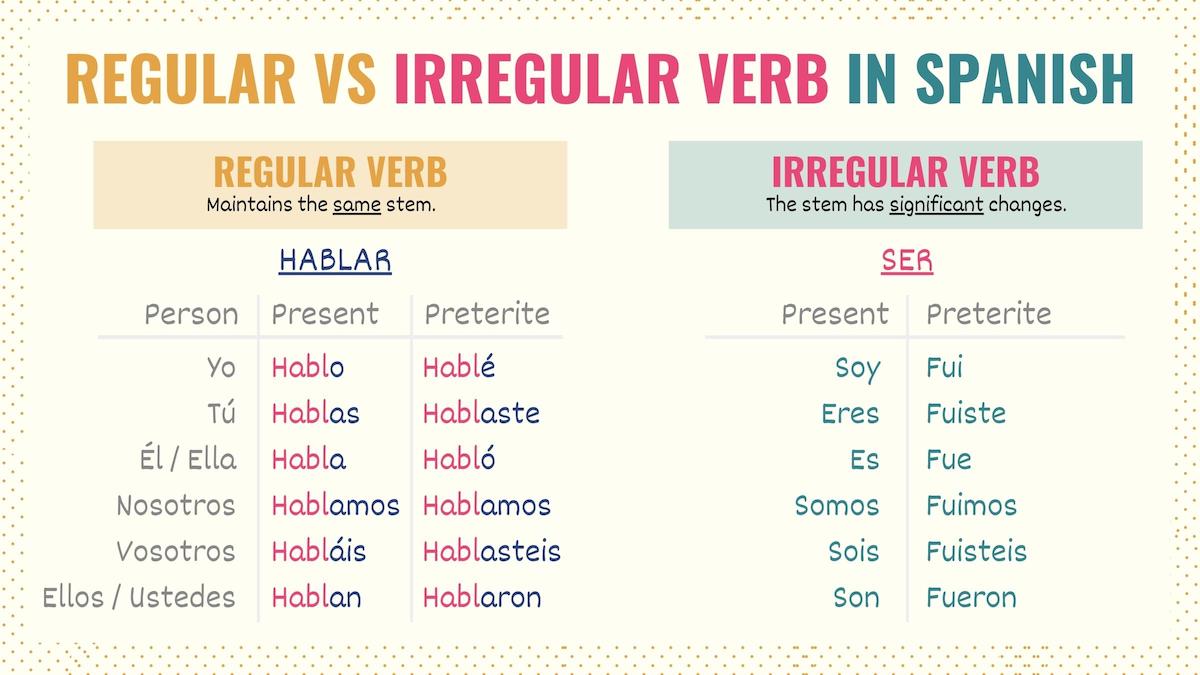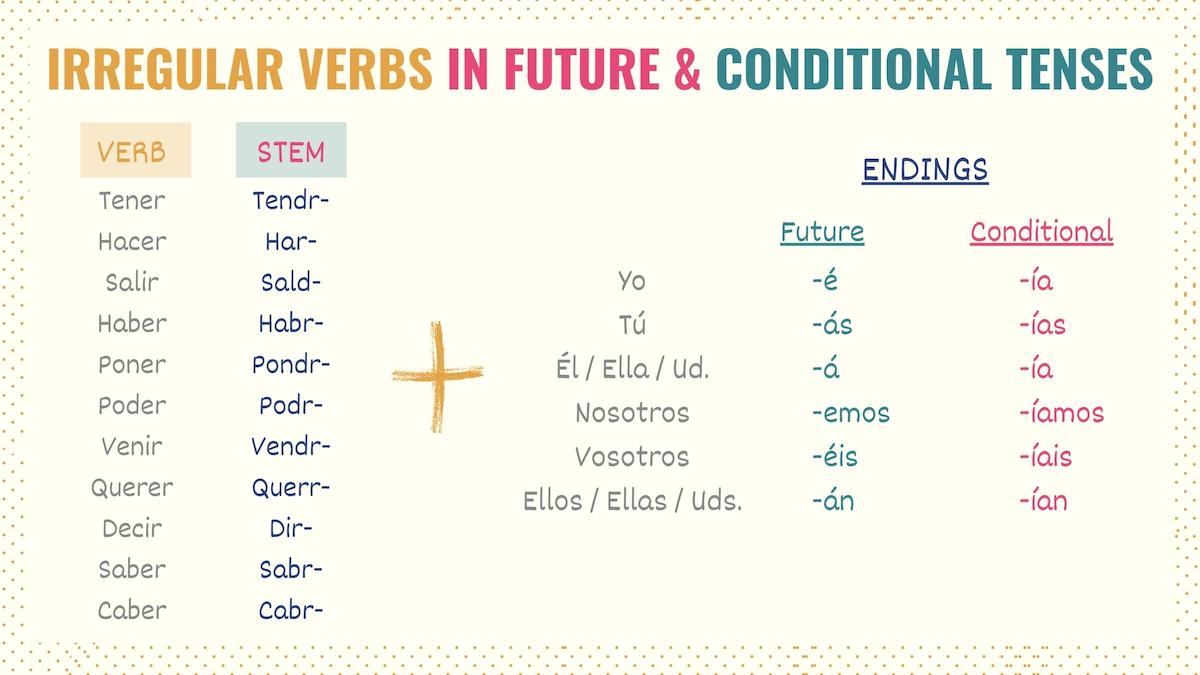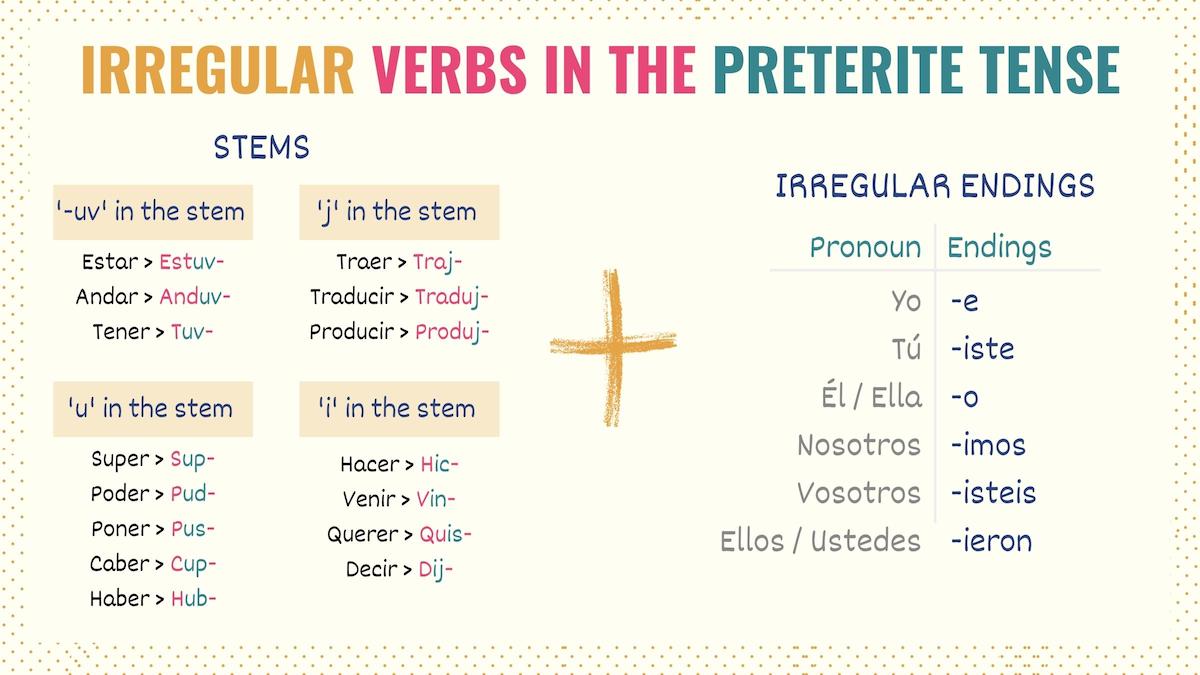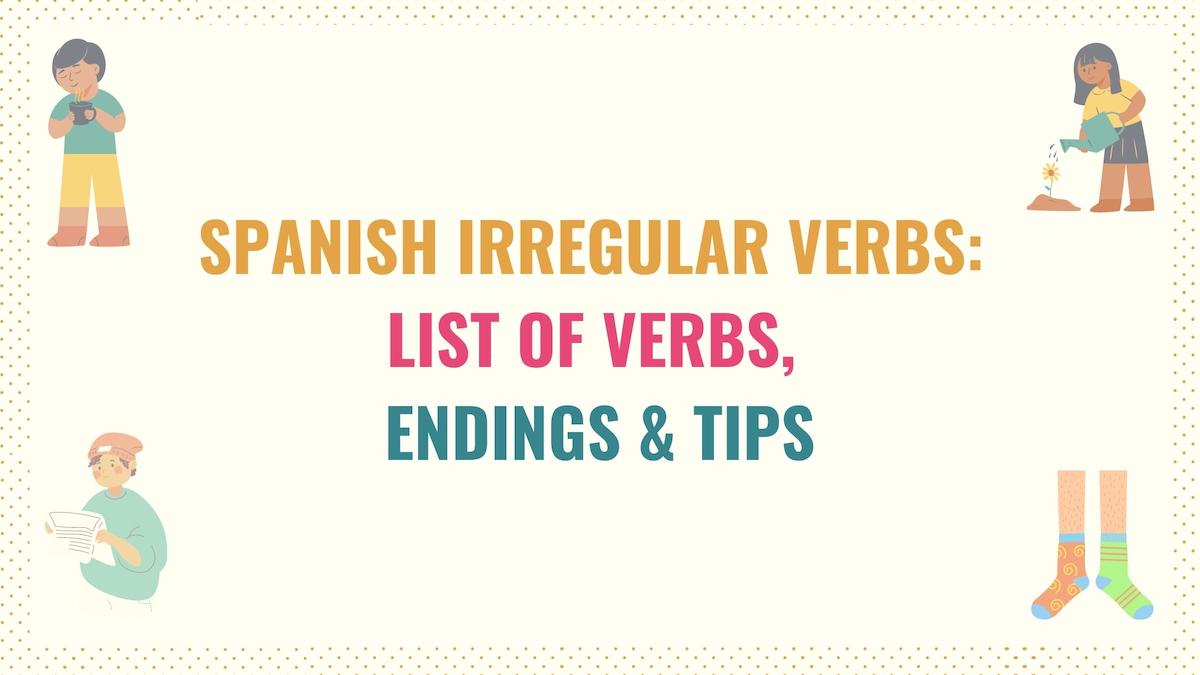When learning to conjugate verbs, you must be aware of Spanish irregular verbs. In fact, many of the most common verbs in Spanish are irregular. So, in this guide, you’ll learn all the key information you must know about this topic. Here is what we’ll go over:
- What Is a Spanish Irregular Verb?
- List of Irregular Verbs in Spanish
- Common Stem-Changing Verbs
- Tips to Conjugate Irregular Verbs
- Additional Resources to Master Spanish Verbs
What Are Irregular Verbs in Spanish?
Spanish irregular verbs are verbs that have significant changes in their root. In simple words, unlike regular verbs, an irregular verb doesn’t follow an identifiable conjugation pattern.

In some cases, the conjugation endings of an irregular verb are also affected. For example, in the preterite tense, irregular endings drop the accent.
| Regular Verb | Irregular Verb |
|---|---|
| Yo comí | Yo hice |
| Tú comiste | Tú hiciste |
| Él / Ella / Usted comió | Él / Ella / Usted hizo |
| Nosotros comimos | Nosotros hicimos |
| Vosotros comisteis | Vosotros hicisteis |
| Ellos / Ellas / Ustedes comieron | Ellos / Ellas / Ustedes hicieron |
Because they have some changes, many people consider stem-changing verbs irregular. However, there’s a big difference between these conjugation patterns.
As established before, irregular verbs in Spanish have significant changes that affect their root and, sometimes, their conjugation endings. Simply put, these verbs have no clear pattern.
On the other hand, a stem-changing verb (such as dormir) has minor spelling changes to ease or maintain the pronunciation.
Take Note: The verb ir is highly irregular in most Spanish tenses. However, other verbs are only irregular in a few tenses or with certain subject pronouns.
List of Spanish Irregular Verbs: 18 Must-Know Verbs
Below is a list of common irregular verbs and a conjugation chart with the expected changes.
1. Ser – To be
| Person | Present | Preterite | Imperfect |
|---|---|---|---|
| Yo | Soy | Fui | Era |
| Tú | Eres | Fuiste | Eras |
| Él / Ella Usted | Es | Fue | Era |
| Nosotros | Somos | Fuimos | Éramos |
| Vosotros | Sois | Fuisteis | Erais |
| Ellos / Ellas Ustedes | Son | Fueron | Eran |
The verb ser in Spanish allows you to describe people or things.
2. Ir – To go
| Person | Present | Preterite | Imperfect | P. Subjunctive |
|---|---|---|---|---|
| Yo | Voy | Fui | Iba | Vaya |
| Tú | Vas | Fuiste | Ibas | Vayas |
| Él / Ella Usted | Va | Fue | Iba | Vaya |
| Nosotros | Vamos | Fuimos | Íbamos | Vayamos |
| Vosotros | Vais | Fuisteis | Ibais | Vayáis |
| Ellos / Ellas Ustedes | Van | Fueron | Iban | Vayan |
In addition to this chart, you should also check the affirmative commands for this verb.
3. Hacer – To do / To make
| Person | Present | Preterite | Future | P. Subjunctive |
|---|---|---|---|---|
| Yo | Hago | Hice | Haré | Haga |
| Tú | Haces | Hiciste | Harás | Hagas |
| Él / Ella Usted | Hace | Hizo | Hará | Haga |
| Nosotros | Hacemos | Hicimos | Haremos | Hagamos |
| Vosotros | Hacéis | Hicisteis | Haréis | Hagáis |
| Ellos / Ellas Ustedes | Hacen | Hicieron | Harán | Hagan |
The root for the future tense (underlined) is also used to form the conditional. Also, notice the hacer conjugations for the present subjunctive use the irregular stem (hag). This root is the same irregular change we see in the present indicative for the first person singular (yo).
4. Poder – To can / To be able
| Person | Preterite | Future | Conditional |
|---|---|---|---|
| Yo | Pude | Podré | Podría |
| Tú | Pudiste | Podrás | Podrías |
| Él / Ella Usted | Pudo | Podrá | Podría |
| Nosotros | Pudimos | Podremos | Podríamos |
| Vosotros | Pudisteis | Podréis | Podríais |
| Ellos / Ellas Ustedes | Pudieron | Podrán | Podrían |
In other tenses, poder has stem changes.
5. Poner – To put
| Person | Present | Preterite | Future | P. Subjunctive |
|---|---|---|---|---|
| Yo | Pongo | Puse | Pondré | Ponga |
| Tú | Pones | Pusiste | Pondrás | Pongas |
| Él / Ella Usted | Pone | Puso | Pondrá | Ponga |
| Nosotros | Ponemos | Pusimos | Pondremos | Pongamos |
| Vosotros | Ponéis | Pusisteis | Pondréis | Pongáis |
| Ellos / Ellas Ustedes | Ponen | Pusieron | Pondrán | Pongan |
Poner conjugations are also irregular when forming commands. Remember to use the same root (underlined) for the future and conditional tense. Finally, notice that the root for the present subjunctive is the same irregular root we use for yo in the present indicative tense.
6. Saber
| Person | Present | Preterite | Future | P. Subjunctive |
|---|---|---|---|---|
| Yo | Sé | Supe | Sabré | Sepa |
| Tú | Sabes | Supiste | Sabrás | Sepas |
| Él / Ella Usted | Sabe | Supo | Sabrá | Sepa |
| Nosotros | Sabemos | Supimos | Sabremos | Sepamos |
| Vosotros | Sabéis | Supisteis | Sabréis | Sepáis |
| Ellos / Ellas Ustedes | Saben | Supieron | Sabrán | Sepan |
In this guide, you can study all the conjugations for saber and practice these patterns.
7. Querer – To want
| Person | Preterite | Future | Conditional |
|---|---|---|---|
| Yo | Quise | Querré | Querría |
| Tú | Quisiste | Querrás | Querrías |
| Él / Ella Usted | Quiso | Querrá | Querría |
| Nosotros | Quisimos | Querremos | Querríamos |
| Vosotros | Quisisteis | Querréis | Querríais |
| Ellos / Ellas Ustedes | Quisieron | Querrán | Querrían |
In addition to these irregularities, querer also has some stem changes you should keep in mind.
8. Decir – To say / To tell
| Person | Present | Preterite | Future | P. Subjunctive |
|---|---|---|---|---|
| Yo | Digo | Dije | Diré | Diga |
| Tú | Dices | Dijiste | Dirás | Digas |
| Él / Ella Usted | Dice | Dijo | Dirá | Diga |
| Nosotros | Decimos | Dijimos | Diremos | Digamos |
| Vosotros | Decís | Dijisteis | Diréis | Digáis |
| Ellos / Ellas Ustedes | Dicen | Dijeron | Dirán | Digan |
Decir also has some irregularities when forming affirmative commands.
Take Note: Verbs that end with ‘go’ in the present indicative (only for ‘yo’) use that irregular stem in the present subjunctive.
10. Haber – To have
| Person | Present | Preterite | Future | P. Subjunctive |
|---|---|---|---|---|
| Yo | He | Hube | Habré | Haya |
| Tú | Has | Hubiste | Habrás | Hayas |
| Él / Ella Usted | Ha | Hubo | Habrá | Haya |
| Nosotros | Hemos | Hubimos | Habremos | Hayamos |
| Vosotros | Habéis | Hubisteis | Habréis | Hayáis |
| Ellos / Ellas Ustedes | Han | Hubieron | Habrán | Hayan |
Haber is a Spanish auxiliary verb, meaning you must get familiar with it since you’ll use it to form compound tenses.
11. Tener – To have
| Person | Present | Preterite | Future | P. Subjunctive |
|---|---|---|---|---|
| Yo | Tengo | Tuve | Tendré | Tenga |
| Tú | Tienes | Tuviste | Tendrás | Tengas |
| Él / Ella Usted | Tiene | Tuvo | Tendrá | Tengan |
| Nosotros | Tenemos | Tuvimos | Tendremos | Tengamos |
| Vosotros | Tenéis | Tuvisteis | Tendréis | Tengáis |
| Ellos / Ellas Ustedes | Tienen | Tuvieron | Tendrán | Tengan |
In Spanish, the verb tener is used as a suffix to form new verbs such as detener or mantener. This means that these words will also follow these conjugation patterns.
12. Estar – To Be
| Person | Present | Preterite | P. Subjunctive |
|---|---|---|---|
| Yo | Estoy | Estuve | Esté |
| Tú | Estás | Estuviste | Estés |
| Él / Ella Usted | Está | Estuvo | Esté |
| Nosotros | Estamos | Estuvimos | Estemos |
| Vosotros | Estáis | Estuvisteis | Estéis |
| Ellos / Ellas Ustedes | Están | Estuvieron | Estén |
In Spanish, the verb estar is used to talk about location and to describe the physical or emotional state of something or someone. Notice that in the subjunctive tense, the endings of these verbs are accented.
13. Traer – To bring
| Person | Present | Preterite | P. Subjunctive |
|---|---|---|---|
| Yo | Traigo | Traje | Traiga |
| Tú | Traes | Trajiste | Traigas |
| Él / Ella Usted | Trae | Trajo | Traiga |
| Nosotros | Traemos | Trajimos | Traigamos |
| Vosotros | Traéis | Trajisteis | Traigáis |
| Ellos / Ellas Ustedes | Traen | Trajeron | Traigan |
14. Ver – To see / To watch
| Person | Present | Preterite | Imperfect |
|---|---|---|---|
| Yo | Veo | Vi | Veía |
| Tú | Ves | Viste | Veías |
| Él / Ella Usted | Ve | Vio | Veía |
| Nosotros | Vemos | Vimos | Veíamos |
| Vosotros | Veis | Visteis | Veíais |
| Ellos / Ellas Ustedes | Ven | Vieron | Veían |
In Spanish, ver is one of the few irregular verbs in the imperfect tense.
15. Salir – To leave
| Person | Present | Future | Conditional | P. Subjunctive |
|---|---|---|---|---|
| Yo | Salgo | Saldré | Saldría | Salga |
| Tú | Sales | Saldrás | Saldrías | Salgas |
| Él / EllaUsted | Sale | Saldrá | Saldría | Salga |
| Nosotros | Salimos | Saldremos | Saldríamos | Salgamos |
| Vosotros | Salís | Saldréis | Saldríais | Salgáis |
| Ellos / EllasUstedes | Salen | Saldrán | Saldrían | Salgan |
Notice that the present indicative of salir is only irregular for ‘yo’. This irregular root will also be used to form the present subjunctive.
16. Venir
| Person | Present | Future | Conditional | P. Subjunctive |
|---|---|---|---|---|
| Yo | Vengo | Vendré | Vendría | Venga |
| Tú | Vienes | Vendrás | Vendrías | Vengas |
| Él / Ella Usted | Viene | Vendrá | Vendría | Venga |
| Nosotros | Venimos | Vendremos | Vendríamos | Vengamos |
| Vosotros | Venís | Vendréis | Vendríais | Vengáis |
| Ellos / Ellas Ustedes | Vienen | Vendrán | Vendrían | Vengan |
Notice that in addition to the irregular conjugation for ‘yo’, the verb venir has some stem changes in the present indicative tense.
17. Andar
| Person | Conjugation |
|---|---|
| Yo | Anduve |
| Tú | Anduviste |
| Él / Ella Usted | Anduvo |
| Nosotros | Anduvimos |
| Vosotros | Anduvisteis |
| Ellos / Ellas Ustedes | Anduvieron |
The verb andar is only irregular when conjugated to the preterite tense.
18. Caber – To fit / To be room for
| Person | Present | Preterite | Future | P. Subjunctive |
|---|---|---|---|---|
| Yo | Quepo | Cupo | Cabré | Quepa |
| Tú | Cabes | Cupiste | Cabrás | Quepas |
| Él / Ella Usted | Cabe | Cupo | Cabrá | Quepa |
| Nosotros | Cabemos | Cupimos | Cabremos | Quepamos |
| Vosotros | Cabéis | Cupisteis | Crabréis | Quepamos |
| Ellos / Ellas Ustedes | Caben | Cupieron | Cabrán | Quepan |
Common Stem-changing Verbs in Spanish
As established before, the changes in stem-changing verbs are so small that they’re often not considered irregular verbs. But since some courses and books classify them as irregular, here is a list of common stem-changing verbs you should know:
- Apagar: To turn off
- Cerrar: To close
- Comenzar: To start
- Despertar: To wake up
- Divertir: To have fun
- Dormir: To sleep
- Contar: To count
- Costar: To cost
- Empezar: To start
- Encontrar: To find
- Jugar: To play
- Medir: To measure
- Mentir: To lie
- Morir: To die
- Querer: To want / To love
- Pedir: To ask
- Pensar: To think
- Preferir: To prefer
- Probar: To taste
- Recordar: To remember
- Repetir: To repeat
- Seguir: To follow
- Servir: To purr / To ser
- Vestir: To get dressed
Tips to Conjugate Irregular Verbs in Spanish
Learning how to conjugate irregular verbs in Spanish can be challenging because these verbs don’t seem to follow a specific pattern. Here some tips you can use to conjugate these verbs:
- Learn the present tense irregular verbs for ‘yo’
- Identify the patterns
- Focus on one tense at a time
- Practice the conjugation
Let’s go through each tip so you can accelerate your conjugation skills with irregular Spanish verbs.
1. Learn the present tense irregular verbs for ‘yo’
In the present tense, many irregular verbs affect the first person singular (yo). Their endings are ‘go’ or ‘oy’.
Below is a list of irregular verbs in the present tense for ‘yo’:
- Tener – tengo
- Decir – digo
- Salir – salgo
- Venir – vengo
- Poner – pongo
- Traer – traigo
- Caer – caigo
- Oír – oigo
- Ser – soy
- Estar – estoy
- Ir – voy
- Dar – doy
Keep in mind that many of these verbs also have irregular forms in other tenses.
2. Identify irregular verb patterns
In Spanish, irregular conjugations have some broad patterns that can make your job easier. For example:
- Verbs in the present tense for the subject ‘yo’ (shown in tip #1).
- Irregular verbs in the future and conditional tense use the same stems.

- Ir and ser have the same conjugation in the preterite tense.
- The preterite endings for irregular verbs are unaccented.
- Verbs with an irregular verb as a suffix follow their parent’s conjugation pattern. For instance, proponer follows the conjugation of poner and mantener is conjugated as tener.
3. Focus on one tense at a time
Spanish tenses have identifiable patterns. As a result, when learning how and when to use a particular tense, you should take the time to identify the list of irregular verbs in that tense.
For instance, the stems of irregular verbs in the preterite tense can be grouped based on their similarities:

4. Practice the irregular conjugation
Once you’ve identified patterns and endings, practicing is the best way to learn how to conjugate an irregular verb in Spanish. To do this, you can write sentences conjugating the irregular verb to different tenses.
You can also take conjugation quizzes that test your knowledge of a specific verb.
Next Steps: Resources for Spanish Verbs & Irregular Verbs
Here are some additional guides that can help you master irregular verbs in Spanish:
- How to conjugate verbs in Spanish: Check this guide to learn some basic conjugation concepts that can help you understand irregular verbs better.
- Stem-changing verbs: In this guide, you’ll learn the spell changes you must consider when conjugating certain verbs.
- List of basic verbs in Spanish: On top of the irregular verbs you learned here, there are other common verbs that can help you improve your conversations. This list also contains conjugation guides so you can study different conjugation models.
Download the Spanish Irregular Verbs PDF
Believe it or not, the Spanish language is easier to learn than English. However, Spanish irregular verbs are one of the harder parts of Spanish to learn since much of it relies on memorization. I’ve created a PDF you can download with the list of verbs you need to know, the tips and more.



